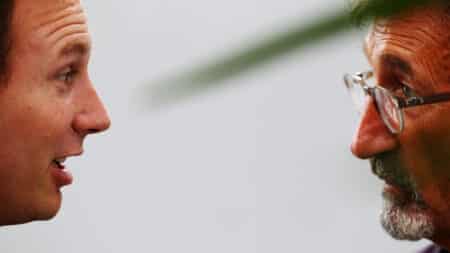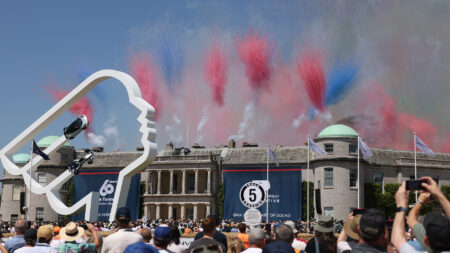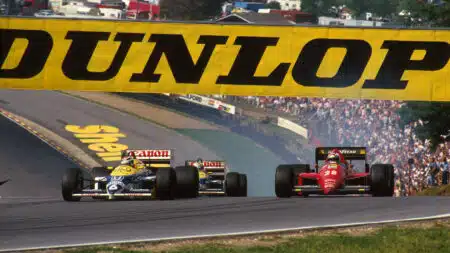
Horner's departure shows age of the maverick F1 boss is over
Christian Horner has now left Red Bull, the last of a certain breed of F1 team principal
It’s been more than 56 years – plus 111 starts for Nico – and yet it was as if it had never been away.
Rosberg’s über-composed maiden Grand Prix win in Shanghai was what Mercedes-Benz in motor sport must be about: domination: shock and awe (Schuey’s radioed reaction to his team-mate’s sizzling time in Q3) plus innovation (that DRS-stalled front wing). That’s why the slinger of the ‘Silver Arrows’ has had to select its top-flight moments so carefully: because domination is difficult to achieve.

The history of Mercedes-Benz in the sport’s elite formula is patchy yet matchless. The stunning effect of its money, men, MO, materials/metallurgy and machines of the 1930s and 1950 forged a brand renowned for its quality and efficiency. Speed and, more usefully for its showroom staff, desirability were byproducts of these motifs.
So deeply seared on the public’s consciousness was this brand that M-B was able to ride its wave for almost 40 years – until Formula 1 started to look towards vast untapped markets. M-B dipped its ‘Concept by’ toe with Sauber in 1993, jumped in up to its waist – and Nigel Mansell’s – with McLaren in 1995, had to wait two years for its first GP win as a supplier of engines, and then further one for its first world titles.
The plunge came, not when it bought 45.1% of Brawn GP – alongside Aabar Investments’ 30% – in November 2009, not even when they went all-in, 60/40, in February 2011, but when the MGP W01 of 2010 was painted silver. Thus it had a lot to live up.

Manfred von Brauchitsch’s bare-metal W25 (above in the French GP) – the car that fletched the nickname – scored a victory on its debut, at the Nürburgring’s Eifelrennen of 1934. With its all-round independent suspension, attention to aerodynamics – faired cowl and headrest, low seating position – and aluminium transaxle with limited-slip diff, this car was the Space Race come early. No matter that it had old hat welded steel water-jackets, or that it blew its charge into its supercharger; no matter that east German rival Auto Union – engine behind the driver, fuel tank between them – was decades ahead of the eventual game, or that it was the first to wear the silver; the shrieking Merc, with almost 150bhp more than the creators of the new 750kg Formula had envisaged, was where it was at.
By 1937, its W125, soothed by supple hydraulic dampers and held in a steadier state by de Dion rear suspension – a basic understeering characteristic with trustworthy 200mph straight-line stability – Mercedes-Benz, sucking not blowing now, had found another 300bhp. My paternal grandfather, an enthusiast who scheduled overseas business trips to happily clash with the second-rank Dieppe GP, was bowled over by them as they blitzed by at Donington Park (below) 50mph faster than he was used to.

It was the same but different by the French GP of July 1954 : stealthier, less boastful; stipulated 2.5 litres unblown rather than deregulated, overblown 5.66. WW2 had reshaped opinion, mores and use of resources, as well as land- and cityscapes, and the silver W196s slid silently from the transporters in Reims’ paddock as spectators gathered agape.
Again, radical met traditional: direct fuel injection, desmodromic valve-gear, sensational all-enveloping shape; a straight-eight, roller bearings, drum brakes (albeit inboard) and, uh oh, welded steel water-jackets. No matter that it was tricky to drive, or that its svelte body was swiftly ditched in favour of ugly open-wheeled practicality, or that Vittorio Jano’s neater but much-delayed Lancia D50 clearly had the potential to beat it, the over-engineered Merc was where it was at.

At Reims, Juan Manuel Fangio and Karl Kling qualified 1-2, lapped the entire field and finished 1-2, a few feet apart. A demonstration run on the day that a superhuman effort by West Germany – 2-0 down after 10 minutes – upset Hungary’s ‘Magic Magyars’ in the World Cup Final. The German Economic Miracle had its sporting feel-good factors.
But hard work, not propaganda, was top of the agenda this time. As such, Mercedes-Benz could not afford to allow its best technicians to continue to go round in small circles at high speed and so withdrew from F1 after just two seasons. (A decision taken many months before its tragic role in the disaster at the Le Mans 24 Hours.) Anyway, why risk chipping the blue chip?

Its last race was September’s Italian GP at Monza. Its preparation was meticulous to the point of organised panic – combinations of long-, medium- and short-chassis, streamliner and open-wheeler, inboard and outboard brakes – that made little difference to the result: another 1-2 led, from pole, by Fangio. Nothing seemed beyond them. At least that’s how it seemed. Covering for shortcomings, making up for shortfalls, were parts of its genius.
There was to be no win-on-debut for the latest iteration of Mercedes-Benz in F1. That’s no bad thing. Its two seasons of relative struggle have put sufficient distance between it and the team’s Tyrrell/BAR/Honda/Brawn GP bloodline to staunch glib accusations of bought success.
F1 is more competitive today than it has ever been. Just two-tenths separated the advancing top 10 from Q2 in China, and the battle for the second and third steps on the podium was akin to a 1960s Monza ding-dong. Yet Rosberg – the first German to win a World Championship GP for a German manufacturer – was gone. As did Renault’s breakthrough Jean-Pierre Jabouille at Dijon in 1979, he missed a jolly exciting race. On pole by half a second, a jackrabbit start, and 20 seconds down the road by the finish, Nico’s performance was mesmerising. Very Mercedes-Benz. A nod to the past that bodes well for the (near) future.

Christian Horner has now left Red Bull, the last of a certain breed of F1 team principal

From Formula 1 icons to futuristic tech and lots of action, here are seven things not to miss at the 2025 Goodwood Festival of Speed

On this day in 1964, the roar of F1 engines echoed through the Kent countryside for the first time, as Brands Hatch made its debut on the world stage

Nico Hülkenberg's long-awaited first podium at Silverstone came after a virtuoso drive, but it only came about thanks to one unforgettable qualifying lap in 2020, as Mark Hughes recalls